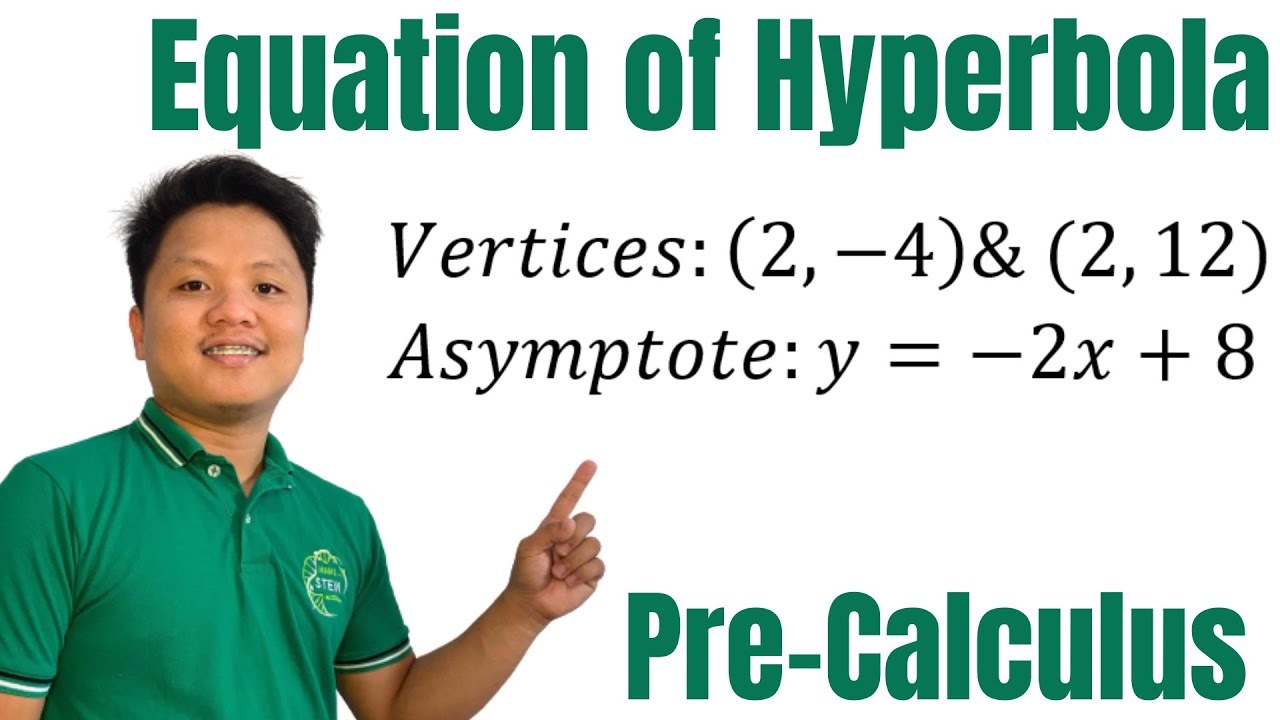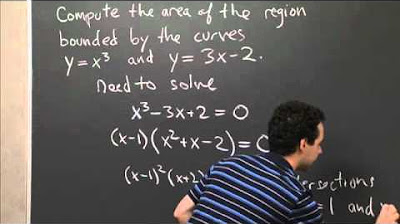Find the equation of Hyperbola given vertices and asymptote
TLDRThis educational video tutorial guides viewers on deriving the standard form equation of a hyperbola when given its vertices and the equation of its asymptote. Two examples are provided: the first explains how to find the equation for a horizontally opening hyperbola with vertices at (-6, 0) and (6, 0), and an asymptote of y = (4/3)x, resulting in the equation x²/36 - y²/64 = 1. The second example demonstrates the process for a vertically opening hyperbola with vertices at (0, 4) and (0, -4), and an asymptote of y = (2/3)x, leading to the equation y²/16 - x²/36 = 1. The video is a helpful resource for understanding the geometric properties and mathematical formulation of hyperbolas.
Takeaways
- 📚 The video is a math tutorial focused on finding the standard form of the equation for a hyperbola given its vertices and the equation of the asymptote.
- 📐 The first example involves a hyperbola with vertices at (-6, 0) and (6, 0) and an asymptote equation of y = (4/3)x.
- 📈 The standard form for a hyperbola with a horizontal transverse axis is \( \frac{x^2}{a^2} - \frac{y^2}{b^2} = 1 \).
- 🔍 The distance from the center to a vertex (a) is found to be 6 units for the first example.
- 🧐 The relationship between the asymptote and the hyperbola's axes is used to find the value of b, resulting in b = 8 for the first example.
- 📝 The final equation for the first hyperbola is \( \frac{x^2}{36} - \frac{y^2}{64} = 1 \).
- 📍 The second example has vertices at (0, 4) and (0, -4) with an asymptote equation of y = (2/3)x.
- 📊 For a hyperbola with a vertical transverse axis, the standard form is \( \frac{y^2}{a^2} - \frac{x^2}{b^2} = 1 \).
- 📏 The distance from the center to a vertex (a) is 4 units for the second example.
- 🔢 Using the asymptote equation, the value of b is calculated to be 6 for the second example.
- 📑 The final equation for the second hyperbola is \( \frac{y^2}{16} - \frac{x^2}{36} = 1 \).
- 👨🏫 The presenter is Prof D, who encourages viewers to ask questions or seek clarifications in the comment section.
Q & A
What is the main topic of the video?
-The main topic of the video is how to find the standard form of the equation for a hyperbola given its vertices and the equation of the asymptote.
What are the coordinates of the vertices given in example one?
-In example one, the vertices are at (-6, 0) and (6, 0).
What is the equation of the asymptote in example one?
-The equation of the asymptote in example one is y = (4/3)x.
Why does the hyperbola in example one open horizontally?
-The hyperbola opens horizontally because its vertices form a horizontal line, indicating a horizontal transverse axis.
What is the general form of the equation for a horizontally opening hyperbola?
-The general form of the equation for a horizontally opening hyperbola is \( \frac{x^2}{a^2} - \frac{y^2}{b^2} = 1 \).
How is the value of 'a' determined in example one?
-In example one, 'a' is determined by the distance between the center and a vertex, which is 6 units, so 'a' equals 6.
How is the value of 'b' calculated in example one?
-In example one, 'b' is calculated using the equation of the asymptote, where \( \frac{4}{3} = \frac{b}{6} \), leading to \( b = 8 \) after cross-multiplication and solving.
What is the standard form of the hyperbola's equation in example one?
-The standard form of the hyperbola's equation in example one is \( \frac{x^2}{36} - \frac{y^2}{64} = 1 \).
What are the coordinates of the vertices given in example two?
-In example two, the vertices are at (0, 4) and (0, -4).
What is the equation of the asymptote in example two?
-The equation of the asymptote in example two is y = (2/3)x.
Why does the hyperbola in example two open vertically?
-The hyperbola opens vertically because its vertices form a vertical line, indicating a vertical transverse axis.
What is the general form of the equation for a vertically opening hyperbola?
-The general form of the equation for a vertically opening hyperbola is \( \frac{y^2}{a^2} - \frac{x^2}{b^2} = 1 \).
How is the value of 'a' determined in example two?
-In example two, 'a' is determined by the distance between the center and a vertex, which is 4 units, so 'a' equals 4.
How is the value of 'b' calculated in example two?
-In example two, 'b' is calculated using the equation of the asymptote, where \( \frac{2}{3} = \frac{a}{b} \) and since 'a' is 4, it leads to \( b = 6 \) after solving.
What is the standard form of the hyperbola's equation in example two?
-The standard form of the hyperbola's equation in example two is \( \frac{y^2}{16} - \frac{x^2}{36} = 1 \).
What advice does the instructor give at the end of the video?
-The instructor advises viewers to leave any questions or clarifications in the comment section if they need further assistance.
Outlines
📚 Introduction to Finding Hyperbola Equations
This paragraph introduces a video tutorial on how to derive the standard form equation of a hyperbola given its vertices and the equation of its asymptote. The video provides a step-by-step guide, starting with an example of a hyperbola with vertices at (-6, 0) and (6, 0) and an asymptote equation of y = (4/3)x. It explains the concept of the transverse axis and how it dictates the orientation of the hyperbola, leading to the selection of the appropriate equation format for a horizontally opening hyperbola: \( \frac{x^2}{a^2} - \frac{y^2}{b^2} = 1 \).
📐 Calculating Hyperbola Parameters from Vertices and Asymptote
The second paragraph delves into the process of calculating the parameters 'a' and 'b' for the hyperbola's equation using the vertices and the asymptote. It first establishes 'a' as the distance from the center to a vertex, which is determined to be 6 units in this case. Then, using the asymptote equation, the relationship between 'a' and 'b' is found by setting up a proportion, leading to the calculation of 'b' as 8 units. The standard form of the hyperbola's equation is then presented as \( \frac{x^2}{36} - \frac{y^2}{64} = 1 \). The paragraph also introduces a second example with different vertices and an asymptote, setting the stage for another calculation of 'a' and 'b', but the explanation for this example is cut off, leaving the process incomplete.
Mindmap
Keywords
💡Hyperbola
💡Standard form
💡Vertices
💡Asymptote
💡Transverse axis
💡Equation
💡Center
💡Distance
💡Substitution
💡Cross multiplication
💡Formula
Highlights
Introduction to finding the standard form of the equation for a hyperbola given its vertices and the equation of the asymptote.
Example 1: Hyperbola with vertices at (-6, 0) and (6, 0) and asymptote y = (4/3)x.
Explanation of the transverse axis and its relation to the orientation of the hyperbola.
The standard form of a hyperbola with a horizontal transverse axis: \( \frac{x^2}{a^2} - \frac{y^2}{b^2} = 1 \).
Calculation of the distance 'a' from the center to the vertex, which is 6 units.
Using the asymptote equation to find the relationship between 'a' and 'b'.
Derivation of 'b' value using the ratio \( \frac{4}{3} = \frac{b}{a} \) where 'a' is 6.
Final equation for Example 1: \( \frac{x^2}{36} - \frac{y^2}{64} = 1 \).
Introduction to Example 2 with vertices at (0, 4), (0, -4) and asymptote y = (2/3)x.
Hyperbola with a vertical transverse axis and the corresponding standard form.
Calculation of 'a' as the distance between the center and vertex, which is 4 units.
Applying the asymptote equation to find 'b' for a vertically opening hyperbola.
Determining 'b' using the relationship \( \frac{2}{3} = \frac{a}{b} \) with 'a' being 4.
Final equation for Example 2: \( \frac{y^2}{16} - \frac{x^2}{36} = 1 \).
Conclusion of the video with a prompt for questions or clarifications.
Sign off by Prof D, indicating the end of the video.
Transcripts
Browse More Related Video

How to find the equation of Hyperbola given vertex, and the equation of asymptote

How to find the equation of an ellipse given foci and vertices | @ProfD

STANDARD EQUATION OF PARABOLA TO ITS GENERAL FORM

GENERAL EQUATION OF THE HYPERBOLA IN STANDARD FORM || PRE-CALCULUS

How To Find The Equation of a Secant Line

Area Between y=x^3 and y=3x-2 | MIT 18.01SC Single Variable Calculus, Fall 2010
5.0 / 5 (0 votes)
Thanks for rating: